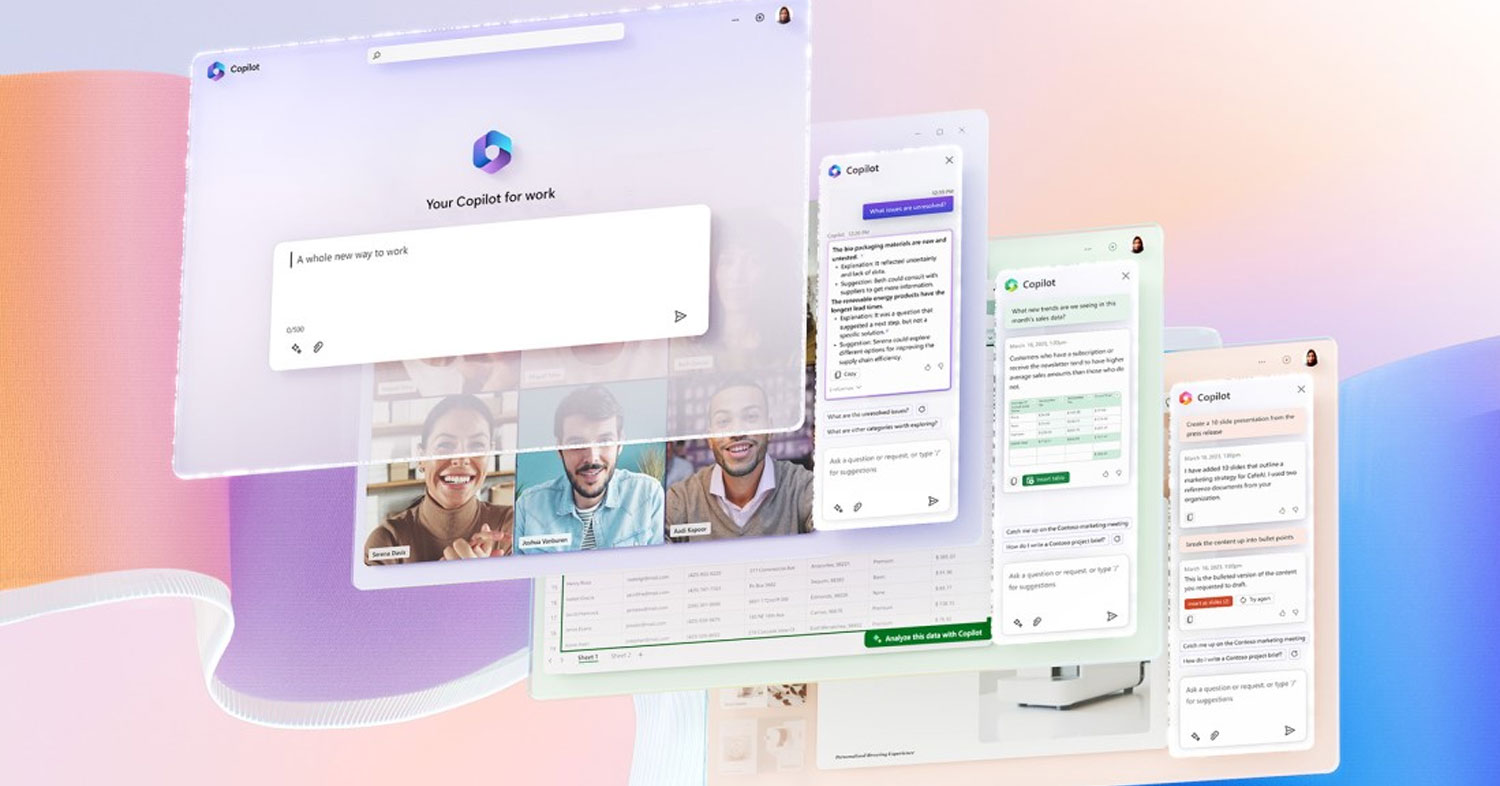
The introduction of ChatGPT has created both huge levels of excitement and concern about the power of generative AI and its potential to change the way we work. Generative AI will bring profound changes to the digital workplace and its future evolution. Digital workplace teams have an important contribution to make in helping organisations and employees get the very best out of the new technology, while navigating the risks.
A significant first step in bringing generative AI into the digital workplace will be the launch of Microsoft Copilot, a way for users to use ChatGPT within an array of Microsoft products to drive productivity. We’re set to hear a lot about Microsoft Copliot in the next few months. Even though it hasn’t really launched yet, there is a lot of anticipation. In this post we’re going to explore what Copilot is, the benefits it will bring, how it will navigate risk concerns and when it is going to be released.
What is Microsoft Copilot?
Microsoft Copilot is basically an integration of ChatGPT with different Microsoft technologies, bringing the power of generative AI right into the tools and apps most of us use each day. It is an outcome resulting from Microsoft’s $10bn investment in Open.AI, the company behind the development of ChatGPT.
Specifically, Copilot will be embedded in an array of tools from Microsoft Word through to the Microsoft Power Platform. It will take advantage of the GPT-4 Large Language Model (LLM) but also the data inside Microsoft Graph. There will be an experience called “Business Chat” that allows users to achieve different tasks using natural language. The specific example Microsoft cite is being able to ask for an update on product strategy and then it generating a status update based on meetings, emails and chats.
Copilot will be launched across multiple places – Word, PowerPoint, Excel, Outlook, Dynamics, Microsoft Viva, One Note, Outlook, the Power Platform and more. In May Microsoft also announced some specific examples of what Copilot will bring to a number of different Microsoft tools. This includes:
- Copilot in Microsoft Whiteboard, allowing users to generate ideas, organise ideas into themes, summarise whiteboard content and even generate designs.
- Copilot in PowerPoint, will automatically integrate the Dall-E image generator (Open.AI’s image generation tool) so users can create custom images for their PowerPoint slides.
- Copilot in Outlook will offer sophisticated tips to improve writing emails.
- Copilot in OneNote will help create plans and lists, and automatically organise notes for you.
- Copilot in Viva Learning will allow users to create their own learning journeys that include suggested resources and even scheduling time in the diary.
 ©Microsoft
©Microsoft
What are the benefits of using Copilot?
Copilot is going to bring a range of benefits to employees and organisations with a Microsoft-powered digital workplace.
1. Productivity
Copilot aims to supercharge employee productivity by automating simpler tasks, helping generate some content, and providing insights to further drive productivity gains. Microsoft are positioning Copilot as a tool that will allow employees to speed through the kind of basic work such as drafting minutes of meetings that can be highly time-consuming and then refocus their time to more creative and valuable activities.
2. Generate content
Microsoft Copilot will help employees to generate content within an application itself – drafting an article within Word or a presentation within PowerPoint, for example. This not only saves time, but also can also support creativity.
3. Unlock insights
Copilot works with a customer’s own data within the Microsoft Graph. The combination of the GPT-4 LLM and Graph has the potential to be very powerful, unlocking insights from data and interactions, while also protecting privacy. These insights will help decision-making and even unearth trends that were previously hidden.
4. Lower barriers to adoption
As Microsoft Copilot will be powered by natural language requests it lowers the barriers to entry in using more of the sophisticated tools of Microsoft 365 such as the Power Platform. Copilot may enable organisations and employees to get more out of the tools they already use and increase adoption, while effectively upskilling employees.
5. Process improvement
Copilot will be used in different ways across different tools, for example in Microsoft Dynamics. We expect that it will lead to multiple specific process improvements across areas such as personal growth and development, customer service, internal communications, and more.
6. Things we haven’t realised yet
ChatGPT and generative AI are set to advance, and therefore so will Copilot. Change is likely to be rapid and exponential. It is possible that Copilot will be helping us in ways that we don’t know about yet.
What will be the risks of using Copilot?
Understandably there has been a lot of focus on the risks of using ChatGPT, particularly around data privacy, the protection of intellectual property and increased threats around Cybersecurity. Microsoft are certainly aware of the associated risks and are making sure Copilot navigates around at least some of these challenges.
Copilot will be embedded within Microsoft tools that already have multiple security, compliance and privacy features built in, so whatever privacy policies are implemented across your existing Microsoft tenant then they should also apply to Copilot.
It’s also important to note that data entered into Copilot stays within your Microsoft tenant; it is not being fed into the general GPT-4 LLM which is what often makes risk departments nervous about the use of ChatGPT. As Microsoft notes, Copilot only “generates answers anchored in your business content .”
Microsoft are also keen to stress that Copilot also respects existing tenant, group and individual data, using any existing permissioning model. Microsoft know how important this will be for Copilot’s success and widespread adoption so we’re confident they will have put the right guardrails in place.
Wider still, Microsoft says it is building Copilot along defined ethical guidelines, aligning with a wider set of defined AI principles.
When will Copilot be released?
Although Copilot was announced in March, at the time of writing this article there still isn’t a confirmed release date for Microsoft Copilot across applications such as the Microsoft Office suite, Teams, Outlook or the Power Platform. However things are moving forward; an early access program was announced in May, building on earlier testing with enterprises like Avanade.
We can expect more announcements and reveals in the coming weeks and months, but it seems very likely that that Copilot will be more widely available later in 2023.
How can Content Formula help?
We’re excited about the potential for Copilot, ChatGPT and generative AI, and the way this will transform the digital workplace. We’re already working with several clients on leveraging the power of Azure Open.AI services that will bring generative AI to your custom business processes.
If you’d like to discuss the upcoming Copilot release, using Azure Open.AI services or how generative AI will impact your wider digital workplace or Microsoft 365 strategy, then get in touch!

Find out more about using Microsoft 365 for your organisation...
Request a call back with one of our MS365 experts, for a free consultation about your business.

